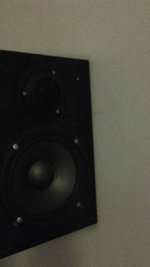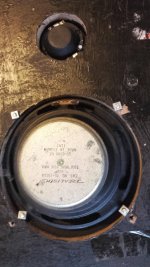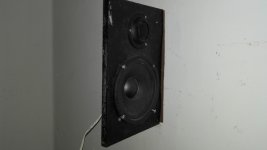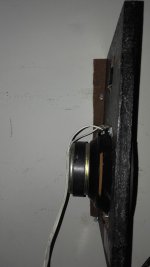Yes indeed.
I just want to point that out because so many OB design neglect the bass loss, and you can hear it - no real bass. OB bass loses can easily run 10dB, which is huge. You have to be prepared to deal with that by pulling down the woofer's midrange.
I just want to point that out because so many OB design neglect the bass loss, and you can hear it - no real bass. OB bass loses can easily run 10dB, which is huge. You have to be prepared to deal with that by pulling down the woofer's midrange.
Pulling down the midrange
Pulling down the midrange by using an equalizer? Equalization helps, but then I am not sure I am getting the best approximation to the original sound.

Best to analyse the sound at the listening position using pink noise.
Yes indeed.
I just want to point that out because so many OB design neglect the bass loss, and you can hear it - no real bass. OB bass loses can easily run 10dB, which is huge. You have to be prepared to deal with that by pulling down the woofer's midrange.
Pulling down the midrange by using an equalizer? Equalization helps, but then I am not sure I am getting the best approximation to the original sound.


Best to analyse the sound at the listening position using pink noise.
You dont need an equalizer, it can also be done in the crossover.
I have used a single capacitor crossover - 4.7 uF as far as I remember or was it 470 uF - in series with the tweeter with a variable resistor to regulate volume of the tweeter.
I built a pair of mini bookshelf speaker some time ago - they sounded marginally better than the powered computer speakers, and found the single capacitor worked for me.
All of this has to go through the listening and spectral analayis stage as well, maybe later. Maybe it won't be Hi-Fidelty.
Any crossover simulators out there? Oh wait there's one http://www.erseaudio.com/First-Order-2-Way
Last edited:
4,7 uF seems to be the right value
For OB you also have to make a baffle step compensation, to get the bass aligned.
you could also use a series resistor or a very large capacitor. There are several ways to do it.
Btw - the link you provide is not a simulator but a calculator - huge difference
You can find a simulator here
http://www.diyaudio.com/forums/software-tools/259865-xsim-free-crossover-designer.html
For OB you also have to make a baffle step compensation, to get the bass aligned.
you could also use a series resistor or a very large capacitor. There are several ways to do it.
Btw - the link you provide is not a simulator but a calculator - huge difference
You can find a simulator here
http://www.diyaudio.com/forums/software-tools/259865-xsim-free-crossover-designer.html
Last edited:
Yep, maybe the best place to do it.You dont need an equalizer, it can also be done in the crossover.
Ha ha. That's the basic misunderstanding right there. You have to flatten the woofer response by EQ somewhere, otherwise it isn't going to be anywhere near flat. And that, by it's very nature, is not an approximation of the original sound.Equalization helps, but then I am not sure I am getting the best approximation to the original sound.
Or look at it this way. Putting a woofer on an open baffle is like applying a big bass cut EQ. If you want to do something about that mechanical bass cut EQ, you have to fix it somewhere, somehow. If you don't - then your frequency response and tonal balance will be seriously about of wack.
Yep, maybe the best place to do it.
Ha ha. That's the basic misunderstanding right there. You have to flatten the woofer response by EQ somewhere, otherwise it isn't going to be anywhere near flat. And that, by it's very nature, is not an approximation of the original sound.
Or look at it this way. Putting a woofer on an open baffle is like applying a big bass cut EQ. If you want to do something about that mechanical bass cut EQ, you have to fix it somewhere, somehow. If you don't - then your frequency response and tonal balance will be seriously about of wack.
That's quite clear then, thanks. Any examples from your measurements of such an environment? Anything on the web?
Also, once I have set up my system, I will want to test it - I have Audacity and the PC microphone, should that be enough to give a reasonable picture of the accuracy of the system or do I need to buy a sensitive mike?😕
You will need a good mic, and soundcard, and some measurement software. REW (Room EQ Wizard) is very popular and free. Audacity is not adapted for this type of work, tho it is good for many other tasks.
I don't know what your local buying situation is. Do you ever order from the USA or Europe?
I don't know what your local buying situation is. Do you ever order from the USA or Europe?
Godzilla's comment
Basic:
I understand that you desire to mount these to one of the walls, but I'm just curious about your reply to Godzilla, who suggested hanging them from chains. You replied that the ceiling would not hold the weight. I cannot imagine how a ceiling could not hold a few pounds. There has to be some structural support somewhere. Either you have floor joists above you, or you have a roof. In either case, they would easily hold the few pounds of weight that these speakers might weigh. If you have a false ceiling, you could extend upward until you reach solid anchoring.
It seems to me that you can place them where you like, and possibly adapt some of the techniques used by Stig and others with their mounting systems that dampen vibrations, etc.
I think that some thin stainless cabling, or some sort of thing might be very attractive, and functional too. I don't have any idea how that might affect other factors, such as a shelf, or bracket might. There are some designs out there where they used glass, or some clear plastic as the baffle, and the drivers appear to float in mid-air. Very cool.
Good luck with your project...it sounds interesting. I'm reading the replies with interest, because a OB design would work well in my decor, if it was not too large. Oh, and my Douglas fir 8" x 14" ceiling beams will surely hold the weight!
Basic:
I understand that you desire to mount these to one of the walls, but I'm just curious about your reply to Godzilla, who suggested hanging them from chains. You replied that the ceiling would not hold the weight. I cannot imagine how a ceiling could not hold a few pounds. There has to be some structural support somewhere. Either you have floor joists above you, or you have a roof. In either case, they would easily hold the few pounds of weight that these speakers might weigh. If you have a false ceiling, you could extend upward until you reach solid anchoring.
It seems to me that you can place them where you like, and possibly adapt some of the techniques used by Stig and others with their mounting systems that dampen vibrations, etc.
I think that some thin stainless cabling, or some sort of thing might be very attractive, and functional too. I don't have any idea how that might affect other factors, such as a shelf, or bracket might. There are some designs out there where they used glass, or some clear plastic as the baffle, and the drivers appear to float in mid-air. Very cool.
Good luck with your project...it sounds interesting. I'm reading the replies with interest, because a OB design would work well in my decor, if it was not too large. Oh, and my Douglas fir 8" x 14" ceiling beams will surely hold the weight!
As long as the correct eye hook is secured into a beam, you would be surprised how much weight the ceiling could hold.
You will need a good mic, and soundcard, and some measurement software. REW (Room EQ Wizard) is very popular and free. Audacity is not adapted for this type of work, tho it is good for many other tasks.
I don't know what your local buying situation is. Do you ever order from the USA or Europe?
I have a new laptop, an HP i3 machine purchased last year. I take it a laptop sound card is not good enough?
I order stuff through ebay - takes time to get here. I recall some branded microphones going for real low prices sometime.
For example
Professional Condenser Microphone Mic Audio Studio Sound Recording + Shock Mount
Panasonic WM-61A Replacement Microphones
Basic:
I understand that you desire to mount these to one of the walls, but I'm just curious about your reply to Godzilla, who suggested hanging them from chains. You replied that the ceiling would not hold the weight. I cannot imagine how a ceiling could not hold a few pounds. There has to be some structural support somewhere. Either you have floor joists above you, or you have a roof. In either case, they would easily hold the few pounds of weight that these speakers might weigh. If you have a false ceiling, you could extend upward until you reach solid anchoring.
It seems to me that you can place them where you like, and possibly adapt some of the techniques used by Stig and others with their mounting systems that dampen vibrations, etc.
I think that some thin stainless cabling, or some sort of thing might be very attractive, and functional too. I don't have any idea how that might affect other factors, such as a shelf, or bracket might. There are some designs out there where they used glass, or some clear plastic as the baffle, and the drivers appear to float in mid-air. Very cool.
Good luck with your project...it sounds interesting. I'm reading the replies with interest, because a OB design would work well in my decor, if it was not too large. Oh, and my Douglas fir 8" x 14" ceiling beams will surely hold the weight!
You are right of course, but there is always that factor to consider - the SAF - I still have not said anything about wall mounting, it's going to be a surprise. 🙂
Each speaker with its MDF baffle ways 1.4 kilogrammes. It's and old speaker from one of my first speaker projects - still sounds clear enough to experiment with.
The rear baffle is the key to getting more bass so I decided to use the rear wall as the rear baffle instead of a large deep box.
Some pictures.
Often, no. They can be OK, if you know who to use them correctly. Most of them now come with a single 1/8" (3.5mm) plug that has left, right and mic connections on it. Or sometimes you have to tell the software what you have plugged in. It's not ideal.I take it a laptop sound card is not good enough?
That mic is not going to work for you, if you want serious measurements. The Panasonic capsule can, but you'll need to build it up and may need a preamp.
This mic is sold under many different names and prices, and works well. They did use that same Panasonic mic capsule, but it is now out of production.
Behringer ECM8000 Measurement Microphone
I have also used this little mic with good success on my iPhone. I don't see why it wouldn't work with a laptop. You would want a extension cord.
Dayton Audio iMM-6 Calibrated Measurement Microphone for Tablets iPhone iPad and Android
Be careful it is easy to lose! (Guess how I know)
Up and tested
Fixing
I finally fixed the OB speaker to the wall, 59 cm from the rear wall. Mounting the speaker on the side wall is a simpler arrangement - thanks for the suggestion. 😎
Testing
Overall the speakers sound acceptable. These are old speakers from about 25 years ago, and one of them has noticeable distortion with some music, and in general, something I do not get with my other test speakers. The main reason for the OB arrangement is clarity, and that certainly is present. It was with some satisfaction that I heard some backing vocals I never heard before, so it is 'revealing' in a way. Only the woofer is connected to my amp which is a 1 watt PC speaker board. Still, I can only imagine what a Fostex would be like.
Alternate Placement
Alternate placement of the other speaker about 13 cm from the rear wall resulted in acceptable sound, what is not acceptable is the placing the OB against the rear wall, that just collapses the sound.
What next
This has been a successful proof of concept. Bass is sufficient compared to the reference 3 box PC speaker system, and that is without any crossovers or equalization. With a good full range it should shine.
The placement of the speakers is awkward and the left side wall has a bookshelf that will obstruct sound. I have to think of another arrangement.
Also a crossover coil of some sort to keep the higher mid ranges out of the woofer.
The Verdict? Go for it!
Fixing
I finally fixed the OB speaker to the wall, 59 cm from the rear wall. Mounting the speaker on the side wall is a simpler arrangement - thanks for the suggestion. 😎
Testing
Overall the speakers sound acceptable. These are old speakers from about 25 years ago, and one of them has noticeable distortion with some music, and in general, something I do not get with my other test speakers. The main reason for the OB arrangement is clarity, and that certainly is present. It was with some satisfaction that I heard some backing vocals I never heard before, so it is 'revealing' in a way. Only the woofer is connected to my amp which is a 1 watt PC speaker board. Still, I can only imagine what a Fostex would be like.
Alternate Placement
Alternate placement of the other speaker about 13 cm from the rear wall resulted in acceptable sound, what is not acceptable is the placing the OB against the rear wall, that just collapses the sound.
What next
This has been a successful proof of concept. Bass is sufficient compared to the reference 3 box PC speaker system, and that is without any crossovers or equalization. With a good full range it should shine.
The placement of the speakers is awkward and the left side wall has a bookshelf that will obstruct sound. I have to think of another arrangement.
Also a crossover coil of some sort to keep the higher mid ranges out of the woofer.
The Verdict? Go for it!
Attachments
Last edited:
Remember that not all full range drivers have the Xmax needed for OB bass. I guess you need at least 5 mm genuine linear Xmax.
I have Cube Audio at home - but still not in use. They might be a candidate
F180 Cube Audio Breitbandlautsprecher
I have Cube Audio at home - but still not in use. They might be a candidate
F180 Cube Audio Breitbandlautsprecher
And, maybe, some more power to "move it".I guess you need at least 5 mm genuine linear Xmax.
10-15 W is about the minimum to "feel" something
Remember that not all full range drivers have the Xmax needed for OB bass. I guess you need at least 5 mm genuine linear Xmax.
I have Cube Audio at home - but still not in use. They might be a candidate
F180 Cube Audio Breitbandlautsprecher
Xmax meaning driver extension - movement range? Large extensions in a full range seems to be a contradiction of sorts. All the time its moving 5 cm back and forth and emitting the higher frequencies all the time, from different positions in space. Sounds like a disaster. Just my 2 cents. Of course we will have to see the measurements.
One question: how do you define which part of the useful output from the speaker- the front one- arrives to you and how it won't be smeared by the error output- the back ( wave)- ?
Of course you have posted it under "multi-way" so this issue it's going to be resolved by using specialized drivers with a X-over network 🙄Xmax meaning driver extension - movement range? Large extensions in a full range seems to be a contradiction of sorts. All the time its moving 5 cm back and forth and emitting the higher frequencies all the time, from different positions in space. Sounds like a disaster
- Status
- Not open for further replies.
- Home
- Loudspeakers
- Multi-Way
- On-Wall Open Baffle Design



